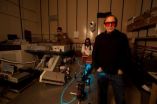(Press-News.org) Naturally occurring high hemoglobin levels are safe for kidney disease patients on dialysis, according to a study appearing in an upcoming issue of the Journal of the American Society Nephrology (JASN). The results suggest that there is no need to lower these levels to protect patients' health.
The vast majority of individuals who develop advanced chronic kidney disease (CKD) also develop progressive anemia, or red blood cell deficiency, that must be treated with medication. Prior to the approval of such erythropoiesis-stimulating agents in 1989, many dialysis patients maintained hemoglobin concentrations < 10 g/dL, with attendant fatigue and the need for repeated blood transfusions. Treatment is controversial, though, because correcting CKD patients' anemia so their target level of hemoglobin, which carries oxygen, is towards the normal range of ~14 g/dL may lead to serious thrombotic complications or even increased risk of death. Researchers have wondered: are dialysis patients whose hemoglobin levels remain high naturally also at risk? Studying these patients provides a natural opportunity to investigate the clinical outcomes associated with higher hemoglobin concentrations in the absence of effects of prescribed drugs.
David Goodkin, MD (Arbor Research Collaborative for Health) and his colleagues studied the health of patients enrolled in the Dialysis Outcomes and Practice Patterns Study (DOPPS), which follows thousands of dialysis patients in 12 countries. Of 29,796 dialysis patients enrolled in the DOPPS with information on hemoglobin levels and medication dose over a 4 month period, 545 (1.8%) maintained hemoglobin concentrations > 12 g/dL without medication to stimulate red blood cell production by the bone marrow.
These patients were more likely to be men, to have been receiving dialysis for more years, and to have underlying cystic kidney disease. Conditions that lower oxygen levels in the blood, such as lung disease, cardiovascular disease, and smoking, were also associated with an increased likelihood of manifesting higher hemoglobin concentrations. The investigators discovered that these patients did not have an elevated risk of dying compared with patients who had lower hemoglobin levels, after adjusting for age, sex, and concomitant diagnoses. Also, there were no differences in mortality between these patients and the subset of other patients who were taking medications to achieve hemoglobin concentrations > 12 g/dL.
While current guidelines caution against prescribing drugs to achieve hemoglobin concentrations > 12 g/dL in kidney disease patients, these findings suggest there is no need to remove blood, or phlebotomize, patients whose hemoglobin levels naturally reach this level without medication. The authors added that "determining the appropriate hemoglobin target range and pharmacological management strategy for dialysis patients is a very complex endeavor and the solution remains a work in progress."
INFORMATION:
Study co-authors include Douglas Fuller, Bruce Robinson, MD, Ronald Pisoni, PhD, Friedrich Port, MD (Arbor Research Collaborative for Health); Christian Combe, MD (University of Bordeaux, in France); Richard Fluck, MD (Royal Derby Hospital, in Derby, the United Kingdom); David Mendelssohn, MD (the University of Toronto, in Weston, Ontario, Canada); and Tadao Akizawa, MD (Showa University School of Medicine, in Tokyo, Japan).
Disclosures: Dr. Goodkin has consulted for Affymax Inc., AMAG Pharmaceuticals, Amgen Inc., Amira Pharmaceuticals Inc., FibroGen Inc., Keryx Biopharmaceuticals, Seattle Life Sciences Inc., Spectrum Pharmaceuticals Inc., and Xenon Pharmaceuticals Inc. Dr. Robinson has received speaker fees from Kyowa Hakko Kirin. Dr. Combe has received speaker fees from Amgen, Ortho Biotech, Genzyme, Shire, Roche, and Sandoz. He has served on advisory boards for Amgen and Roche and has received research grants from Amgen (site investigator), Ortho Biotech (principal investigator for France), and Roche (site investigator). Dr. Fluck has received consultancy fees, support for attendance at meetings, and honoraria from Amgen, Ortho Biotech, and Roche. Dr. Mendelssohn has received speaker fees from and has served on the advisory boards of Amgen, Ortho Biotech, and Roche, and has received research grants from Amgen (site investigator) and Ortho Biotech (principal investigator, multicentre studies). Dr. Akizawa has consulted for Kirin and Chugai and has received grants from Kirin, Chugai, Fresenius, and Tomita. Dr. Pisoni has received speaker fees from Amgen, Kyowa Hakko Kirin, and Vifor and has served on an advisory panel for Merck. The DOPPS is administered by Arbor Research Collaborative for Health and is supported by scientific research grants from Amgen, Kyowa Hakko Kirin, Genzyme, and Abbott, without restrictions on publications. Drs. Goodkin, Robinson, Pisoni, and Port are DOPPS investigators.
The article, entitled "Naturally Occurring Higher Hemoglobin Concentration Does Not Increase Mortality among Hemodialysis Patients," will appear online at http://jasn.asnjournals.org/ on December 16, 2010, doi 10.1681/ASN.2010020173.
The content of this article does not reflect the views or opinions of The American Society of Nephrology (ASN). Responsibility for the information and views expressed therein lies entirely with the author(s). ASN does not offer medical advice. All content in ASN publications is for informational purposes only, and is not intended to cover all possible uses, directions, precautions, drug interactions, or adverse effects. This content should not be used during a medical emergency or for the diagnosis or treatment of any medical condition. Please consult your doctor or other qualified health care provider if you have any questions about a medical condition, or before taking any drug, changing your diet or commencing or discontinuing any course of treatment. Do not ignore or delay obtaining professional medical advice because of information accessed through ASN. Call 911 or your doctor for all medical emergencies.
Founded in 1966 and comprised of more than 12,000 members, the American Society of Nephrology (ASN) leads the fight against kidney disease by educating health professionals, sharing new knowledge, advancing research, and advocating the highest quality care for patients.
Cystatin C, a blood marker of kidney function, proved significantly more accurate than the standard blood marker, creatinine, in predicting serious complications of kidney disease, in a study by researchers at the San Francisco VA Medical Center and the University of California, San Francisco.
Among adults who were identified as having chronic kidney disease by high creatinine levels, the researchers found that only patients who also had abnormally high levels of cystatin C were at high risk for death, cardiovascular disease, heart failure, or kidney failure. People with ...
A new study provides fascinating insight into the underlying pathology associated with the autoimmune disease, systemic lupus erythematosus (SLE). The research, published by Cell Press in the December issue of the journal Immunity, reveals an unexpected role for a key type of immune cell and provides a potential new therapeutic strategy for SLE and, potentially, other autoimmune diseases.
SLE is a chronic systemic disease that can affect many regions of the body and, as a result, presents with diverse clinical symptoms. As is characteristic of other autoimmune disease, ...
Until this year, all human-made objects have moved according to the laws of classical mechanics. Back in March, however, a group of researchers designed a gadget that moves in ways that can only be described by quantum mechanics—the set of rules that governs the behavior of tiny things like molecules, atoms, and subatomic particles. In recognition of the conceptual ground their experiment breaks, the ingenuity behind it and its many potential applications, Science has called this discovery the most significant scientific advance of 2010.
Physicists Andrew Cleland and ...
SALT LAKE CITY, Dec. 16, 2010 – University of Utah physicists stored information for 112 seconds in what may become the world's tiniest computer memory: magnetic "spins" in the centers or nuclei of atoms. Then the physicists retrieved and read the data electronically – a big step toward using the new kind of memory for both faster conventional and superfast "quantum" computers.
"The length of spin memory we observed is more than adequate to create memories for computers," says Christoph Boehme (pronounced Boo-meh), an associate professor ...
The greater susceptibility of humans to certain infectious diseases when compared to other primates could be explained by species-specific changes in immune signaling pathways, a University of Chicago study finds. The first genome-wide, functional comparison of genes regulated by the innate immune system in three primate species discovers potential mediators of differences in disease susceptibility among primates. These findings are published on December 16 in the open-access journal PLoS Genetics.
Humans are more sensitive than chimpanzees to the severe effects of certain ...
December 16, 2010 - Scientists have discovered that a class of materials known to convert heat to electricity and vice versa behaves quite unexpectedly at the nanoscale in response to changes in temperature. The discovery - described in the December 17, 2010, issue of Science - is a new "opposite-direction" phase transition that helps explain the strong thermoelectric response of these materials. It may also help scientists identify other useful thermoelectrics, and could further their application in capturing energy lost as heat, for example, in automotive and factory ...
CAMBRIDGE, Mass. -- Researchers have created a powerful new approach to scholarship, using approximately 4 percent of all books ever published as a digital "fossil record" of human culture. By tracking the frequency with which words appear in books over time, scholars can now precisely quantify a wide variety of cultural and historical trends.
The four-year effort, led by Harvard University's Jean-Baptiste Michel and Erez Lieberman Aiden, is described this week in the journal Science.
The team, comprising researchers from Harvard, Google, Encyclopaedia Britannica, ...
New genes that have evolved in species as little as one million years ago – a virtual blink in evolutionary history – can be just as essential for life as ancient genes, startling new research has discovered.
Evolutionary biologists have long proposed that the genes most important to life are ancient and conserved, handed down from species to species as the "bread and butter" of biology. New genes that arise as species split off from their ancestors were thought to serve less critical roles – the "vinegar" that adds flavor to the core genes.
But when nearly 200 new ...
Gamma-ray bursts (GRBs), fleeting events that last from less than a second to several minutes, are detected by orbiting observatories that can pick up their high energy radiation. Thirteen years ago, however, astronomers discovered a longer-lasting stream of less energetic radiation coming from these violent outbursts, which can last for weeks or even years after the initial explosion. Astronomers call this the burst's afterglow.
While all gamma-ray bursts [1] have afterglows that give off X-rays, only about half of them were found to give off visible light, with the ...
Nearly two-thirds of Medicare beneficiaries discharged from hospitals after ischemic stroke die or are readmitted within one year, researchers report in Stroke: Journal of the American Heart Association.
Stroke is the second leading cause of hospital admissions among older adults in the United States, according to American Heart Association/American Stroke Association statistics. Ischemic stroke, which occurs as a result of an obstruction within a blood vessel supplying blood to the brain, accounts for 87 percent of all strokes.
Only a few contemporary studies have ...

